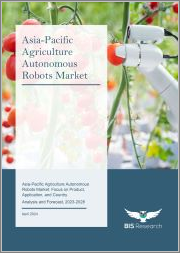
중국을 제외한 아시아태평양의 농업용 자동 로봇 시장 규모는 2023년 1억 2,120만 달러에서 예측 기간 중 CAGR 23.45%로 추이하며, 2028년에는 3억 4,760만 달러 규모로 성장할 것으로 예측됩니다.
농업용 자동 로봇 시장의 성장이 기대되는 배경에는 효율적 및 지속가능한 농법에 대한 수요의 증가가 있습니다.
| 주요 시장 통계 | |
|---|---|
| 예측 기간 | 2023-2028년 |
| 2023년 평가 | 1억 2,120만 달러 |
| 2028년 예측 | 3억 4,760만 달러 |
| CAGR | 23.45% |
아시아태평양의 농업용 자동 로봇 시장은 이 지역의 변화하는 농업 환경과 첨단 기술 도입 증가에 힘입어 큰 성장을 이룰 것으로 예상됩니다. 아시아태평양은 대규모의 다양한 농업 부문을 보유하고 있으며, 생산성, 효율성, 지속가능성을 높이기 위한 필요성이 증가하고 있습니다. 자동 로봇은 심기, 모니터링, 수확, 농약 살포 등 다양한 작업을 자동화함으로써 이러한 과제를 해결할 수 있는 솔루션을 제공합니다. 또한 노동력 부족, 인건비 상승, 정밀농업의 필요성 등이 이 지역의 자동 로봇에 대한 수요를 더욱 증가시키고 있습니다. 중국, 일본, 인도, 호주 등의 국가에서는 정부의 구상과 기술 발전, 농업 자동화의 이점에 대한 인식이 높아지면서 농업용 자동 로봇의 도입이 급증하고 있습니다. 아시아태평양의 농업 관행이 지속적으로 현대화됨에 따라 아시아태평양의 농업용 자동 로봇 시장은 견고한 성장과 혁신이 예상됩니다.
아시아태평양의 농업용 자동 로봇 시장을 조사했으며, 업계의 동향, 에코시스템, 진행중인 프로그램, 사례 연구, 시장 규모의 추이·예측, 지역/주요 국가별 상세 분석, 경쟁 구도, 주요 기업의 개요 등을 정리하여 전해드립니다.
시장 세분화
세분화 1 : 용도별
세분화 2 : 제품별
세분화 3 : 국가별
Introduction to Asia-Pacific Agriculture Autonomous Robots Market
The Asia-Pacific agriculture autonomous robots market (excluding China) was valued at $121.2 million in 2023, and it is expected to grow with a CAGR of 23.45% during the forecast period to reach $347.6 million by 2028. The expected growth of the agriculture autonomous robots market is propelled by the growing demand for agricultural practices that are both efficient and sustainable.
| KEY MARKET STATISTICS | |
|---|---|
| Forecast Period | 2023 - 2028 |
| 2023 Evaluation | $121.2 Million |
| 2028 Forecast | $347.6 Million |
| CAGR | 23.45% |
Market Introduction
The Asia-Pacific (APAC) Agriculture Autonomous Robots market is poised for significant growth fueled by the region's evolving agricultural landscape and the increasing adoption of advanced technologies. With the APAC region being home to a large and diverse agricultural sector, there's a growing need to enhance productivity, efficiency, and sustainability. Autonomous robots offer solutions to address these challenges by automating various tasks such as planting, monitoring, harvesting, and spraying pesticides. Additionally, factors such as labor shortages, rising labor costs, and the need for precision agriculture further drive the demand for autonomous robots in APAC. Countries like China, Japan, India, and Australia are witnessing a surge in the adoption of agriculture autonomous robots, supported by government initiatives, technological advancements, and a growing awareness of the benefits of automation in agriculture. As the region continues to modernize its farming practices, the APAC Agriculture Autonomous Robots market is expected to experience robust growth and innovation.
Market Segmentation:
Segmentation 1: by Application
Segmentation 2: by Product
Segmentation 3: by Country
How can this report add value to an organization?
Product/Innovation Strategy: The product segment helps the reader understand the different technologies used for agriculture autonomous robots and their potential. Moreover, the study gives the reader a detailed understanding of the different solutions provided by the agriculture autonomous robot equipment providers, such as imaging, AI, and analyzing. Compared to conventional agricultural methods, the agriculture autonomous robots market enables more exact targeting of planting, weeding, and harvesting, allowing farmers to save money by maximizing the use of their inputs.
Growth/Marketing Strategy: The agriculture autonomous robots market has seen major development by key players operating in the market, such as business expansion, partnership, collaboration, and joint venture. The favored strategy for the companies has been partnership, collaboration, and joint venture activities to strengthen their position in the Asia-Pacific agriculture autonomous robots market.
Competitive Strategy: Key players in the Asia-Pacific agriculture autonomous robots market analyzed and profiled in the study, including their market segments covered by distinct products, applications served, and regional presence, as well as the influence of important market tactics. Moreover, a detailed competitive benchmarking of the players operating in the Asia-Pacific agriculture autonomous robots market has been done to help the reader understand how players stack against each other, presenting a clear market landscape. Additionally, comprehensive competitive strategies such as partnerships, agreements, and collaborations will aid the reader in understanding the untapped revenue pockets in the market.